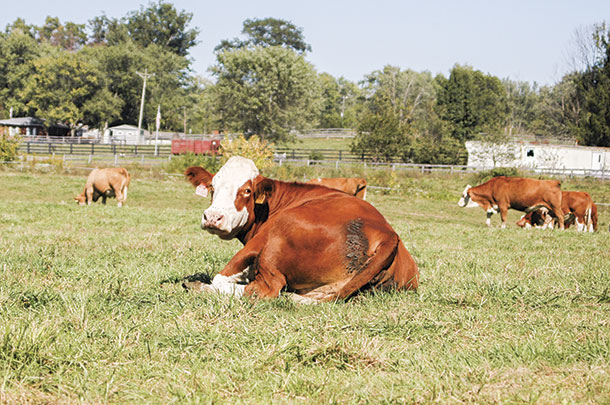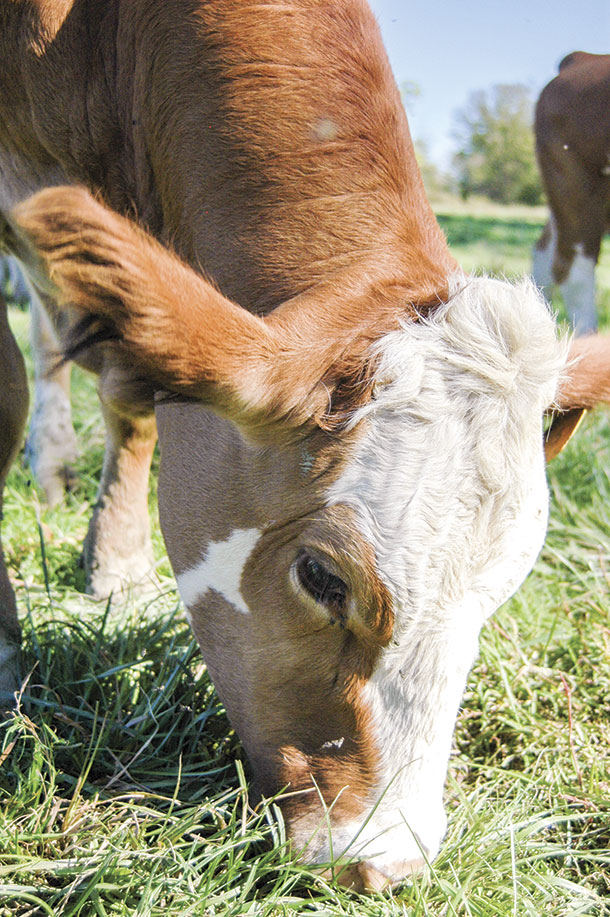The Bluegrass State has a rich agriculture history that claims centuries of tobacco production and renowned race horses. It only makes sense the rolling green hills are home to 1.1 million head of cattle.
Surprisingly, with that large number of cattle, Kentucky is primarily made up of small commercial producers and seedstock operations. According to Roy Burris, University of Kentucky beef specialist, the average cattle operation has around 25 to 30 head of mother cows.
There are larger producers in the northeast and north-central part of Kentucky, but the smaller ones across the whole state make up a good portion of the population. According to the Kentucky Cattleman’s Association, there are more than 38,000 cattle producers in Kentucky.
“People love producing beef cattle,” Burris says. “We love the business.”
The Kentucky cattleman
Bell’s Angus Farm is a 30-head Black Angus seedstock operation in the north-central part of Kentucky. It has been in the family for generations. Just like an average operation, they graze their cattle, feed corn and try to keep up with everything.
“We don’t face a lot of problems; you got to just change with the times,” Bobby Bell says. “We try to manage our herd the right way and try to prevent problems; that’s what we do.”
At Bell’s Angus Farm they calve twice a year, fall and spring, to present different options to buyers. They market their purebred bulls and heifers, and take the rest of the calf crop to the local sale barn.
The farm isn’t too far from Louisville, Kentucky, but Bell appreciates that it’s still surrounded by grain and tobacco farms, and other cattle operations.
“There aren’t any more family farms left,” Bell says. “We need more of them.”
The cattle industry keeps Bell busy on and off the farm. Not only is Bell a member of the American Angus Association, but he is the president of the Breckinridge County Cattle Association. He recruits members and does a lot community outreach work.
“We do a lot of fundraisers and give scholarships to graduating seniors,” Bell says. “We help donate money back to youth programs to try and get the youth involved in the livestock business.”
Getting youth involved is very important in the beef industry. It is a way of life many can’t deny and, once it’s started, it’s tough to stop.
Rick Williams got into the cattle business 40 years ago by accident. He bought a northern Kentucky farm for a land investment – and then realized it needed cattle.
“Come to find out, you have to operate it to keep it cleaned up,” Williams says. “After I retired, I got more cattle and got a little bit bigger.”
He now runs 60 head of mother cows between the first farm he purchased plus another one he got after he retired. There is only about four months out of the year calving is not happening on Williams’ operation; other than that, it’s year-round.
“I don’t have any calves born during the bad winter time; December, January, February are three months definitely don’t want to be calves in our area,” Williams says. “Rest of the time, it’s an ongoing calving season.”
Every year he tries to get good prices and takes his calf crop to a sale barn in Lexington, Kentucky.
“I try to get the biggest part of them in February,” Williams says. “I have taken a bunch in the fall too for the ones who calved later on.”
Williams trades bulls with the neighbors to rotate bloodlines but purchases a registered bull every couple of years to get those solid genetics.
“I don’t have the time and facilities to put them in and get them to breed on time,” Williams says. “So I just breed strictly with a bull.”
Williams stays very busy running the operation by himself, but it’s something he doesn’t want to stop doing.
“I bought the farm for a land investment, and I had to put some cattle on it to keep it cleaned up,” Williams says. “After I got having calves born and raised them up to market size, it just kind of got into my blood.”
Universal breeding
Every producer is searching for strong genetic traits that are passed down through a herd. When Larry Maxey got into the cattle business almost 50 years ago, he was intrigued with the strong traits in the Simmental breed.
“My whole idea from the very beginning was to eventually become a seedstock producer and sell breeding bulls and breeding females for others who wanted to have this type of cattle,” Maxey says.
Maxey Valley Farms started in 1973, and Maxey now owns 80 head of Fleckvieh Simmental cattle. The Simmental breed has been around for nearly 50 years, but the breed is not traditionally black.

Maxey explains so many cattle have been infused with the Black Angus gene, making the color black very dominant. Maxey takes pride that his dark yellow and red Fleckvieh Simmentals stick out in the sea of black.
“What we have here is traditional full-blood Simmentals,” Maxey says. “I saw a need for these cattle when I came in, and I still see a need.”
With this universal breed, Maxey markets his bull semen domestically and internationally. He also markets his heifers and cow embryos. According to Maxey, the Fleckvieh Simmental gene was eventually isolated in South Africa, and he now wholly focuses on that gene out of that area.
“We have nothing but full-blood cattle; we made sure we washed out all the other bloodlines,” Maxey says. “We are probably the only ones in North America when it comes to just focusing on those genetics that originated out of South Africa.”
Maxey has seen the change and progress in beef genetics over the years. With genetic research and hybrid vigor, the beef industry has seen its fair share of advances. He takes pride in the quality genes his herd provides to other producers.
“There is just a lot of interest in getting those genetics back into the gene pool for beef cattle,” Maxey says. “They need this infusion of the growth and milk these cattle provide.”
Lexington, Kentucky, is the only place in North America to have a full-blood Simmental show, the Pinnacle Show, and Maxey was involved in starting it. He felt the Simmental shows needed to be separate because of the difference between the two breeds.
“There’s several people around us who still have the traditional Simmental,” Maxey says. “All of the other black cattle come back to this Fleckvieh to infuse their cattle with this gene and get them back to the reason they were brought into North America in the first place.”
Strength in education
In previous decades, Kentucky relied heavily on tobacco production. Around 80,000 farms grew the cash crop, and the state was known for their tobacco. Everything changed in the 1990s when the Master Settlement Agreement was finalized due to various issues, health being one of them, and the agriculture way of life started to change in Kentucky.
According to Burris, the Kentucky Agriculture Development Board made beef producers a priority.

“Since the tobacco program phased out, we had to step up our game in the beef cattle business,” Burris says. “We tried to ensure beef cattle producers got benefits from the tobacco settlement money that they were aligned.”
Burris explains that since the ’90s there has been a structured effort to make Kentucky become a major player in the cattle business, and education was the key.
“We tried to ask ourselves, on many levels: ‘What do we have to make us better and what do we need to have?’” Burris says. “We wanted to have the best-educated producers in the country.”
To better educate producers, University of Kentucky started the Master Cattleman program in 2000. This program is still active today, and its purpose is to certify producers in what Burris calls an “intense” program. Specialists teach producers about nutrition, cattle handling, reproduction, genetics, etc., at multiple locations in the state.
“We want our producers to get that,” Burris says. “Our goal is at least 10 percent producers certified.”
Burris explains that in the past, the people who relied heavily on tobacco production let their herd management slide. It wasn’t their cash crop. Then after the programs went out, people started relying on beef cattle more seriously for their income. There are now more than 4,000 Master Cattleman certified producers.
“We feel like since 2000, we’ve probably done a lot to improve the quality of Kentucky feeder calves,” Burris says. “Hopefully people who buy Kentucky feeder calves have a good experience and come back and buy more.”
Burris has observed that, typically, the old producers have enjoyed having a few head of cattle along with their other crops. But most of the younger producers who are getting in the industry now have a sharper pencil and are very serious about doing a good job in the cattle business.
“Beef cattle fit well in places where you already have the land you’re trying to maximize,” Burris says. “If only we could consistently get favorable prices.” ![]()
PHOTO 1: Photo taken in northern Kentucky, in between Lexington and Cincinnati.
PHOTO 2: Pastures surround Maxey Valley Farms for the Simmentals to graze and allows Maxey to keep a close eye on the herd.
PHOTO 3: Cattle fit well in Kentucky where they already have plenty of green grass and land to utilize, according to Burris. Photos by Jamie Hawley.
Jamie Hawley is a freelance writer based in Ohio. Email Jamie Hawley.







